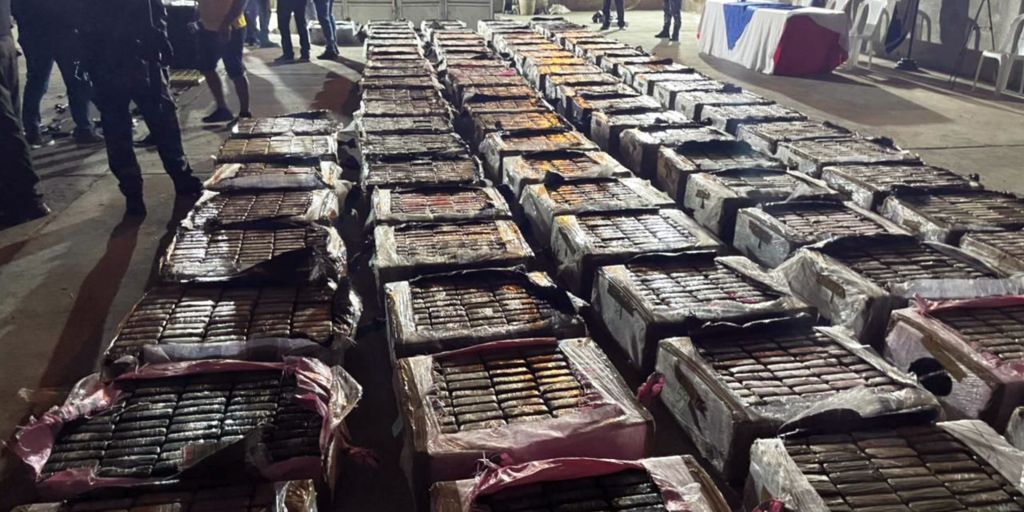The national police of Ecuador seized nearly ten tons of cocaine valued at around half a billion dollars, a record haul that underscores the country’s position as a major transshipment point for narcotics originating in South America.
The police discovered the drugs hidden behind a fake wall in a building disguised as a water purification factory on August 13, in the coastal city of Guayaquil–a major port for narcotics headed to the United States and Europe.
Videos by VICE
The historic seizure of 9.6 tons of cocaine broke a record for Ecuador that was set in late June when port authorities encountered more than seven tons of cocaine stashed among canned tuna inside shipping containers headed for Spain.
Over the past two months, Ecuadorian authorities have seized almost 20 tons of cocaine in Guayaquil alone–equivalent to roughly ten percent of the estimated combined annual production capacity of the world’s largest cocaine exporters Colombia, Peru and Bolivia.
“It’s not surprising at all that this amount of drugs is being moved through Guayaquil,” said James Bargent, an analyst who studies Ecuador for Insight Crime, a think tank focused on organized crime and drug trafficking in Latin America. “What’s new and what’s surprised me is that it’s been seized.”
The reason behind the sudden seizures of such large amounts of cocaine isn’t clear. President Guillermo Lasso took office on May 24, breaking a string of more than 14 years of one-party rule. A changing of the guard could disrupt corrupt networks, or the new administration could just be a beneficiary of lucky timing.
Ecuador is not a major producer of cocaine, but over the past two decades crackdowns on drug trafficking routes out of Colombia, the closure of a United States naval base, the dollarization of the economy and the country’s strategic location made it a key jump off point for drug shipments headed to the U.S. and Europe. Today, roughly a third of the cocaine produced in Colombia passes through Ecuador, according to estimates from Insight Crime.
The small Andean nation doesn’t have large cartels, but rather “service providers” who are hired by drug trafficking organizations from Colombia, Mexico or even Albania, to smuggle shipments from one point to another, according to Bargent. It isn’t known which group or groups were trafficking the cocaine seized over the past two months, but the busts are likely related somehow.
Drug smugglers don’t typically sit on large stashes. The construction of a false wall with no easy access to the cocaine suggests that the owners had been holding on to it for some time already, or intended to. The first big seizure in June could be the cause for the delay.
“If you lose seven tons you want to know why you lost it. Is your network compromised? Have you been ratted out? Is a rival providing information on you? Or was it just a lucky strike on the part of the authorities?” said Bargent.
The police are holding their cards close to their chest. In a press conference following the record seizure, national police commander Tannya Varela said that authorities had first raided the building on July 23, encountering about 500 kilos of cocaine and arresting five people.
Subsequent advances in the investigation led the police to return for a more exhaustive search. A video shared by police on social media shows an officer with a pickaxe busting a hole through a thin, tiled wall, behind which they found the stash of cocaine as well as high powered weapons and ammunition. Two additional people were arrested in relation to the second seizure.
The police indicated that the cocaine was likely headed to Mexico and the U.S., part of it by sea and the rest via planes launched from nearby clandestine airstrips.
But most drugs that go through Guayaquil, the country’s second-largest city and home to one of the busiest ports in Latin America, are hidden in shipping containers headed for Europe through the Panama Canal. Ecuador has confiscated 116 tons of cocaine so far this year, compared with 128 tons in all of 2020.
Although the most recent seizure is a record for Ecuador, it dwarfs the 23.5 tons that were seized from the Mexican port of Manzanillo in 2007. In February, police in Germany and Belgium announced that they had seized 23 tons of cocaine in containers at the ports of Hamburg and Antwerp, hidden in goods all bound for the same destination in the Netherlands.






